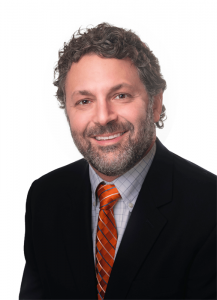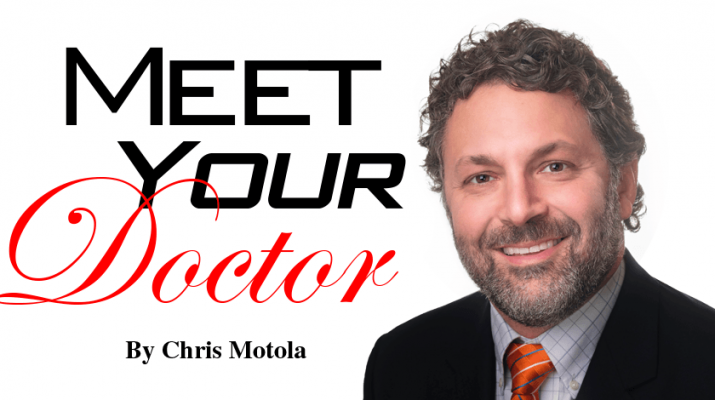Lead orthopedist for the Syracuse University football team shares his experience caring for the athletes
By Chris Motola

Q: Tell us about your experience taking care of the Syracuse University football team.
A: It’s the most enjoyable portion of my job. I travel with them, cover their games, spend a lot of time in practice. It’s just a very rewarding way to stay involved in sports when you’re a little too old to participate yourself.
Q: What’s the most interesting story you have from doing college sports medicine?
A: It’s hard to get into specifics due to confidentiality, but we’ve seen some pretty unique injuries that you don’t see with your high school or recreational athletes. Open fractures, major ligament injuries and dislocations, tears of muscles off the pelvis — some unusual injuries that come from the speed and weight at which those guys play. The amount of trauma they put themselves through in each game, it’s kind of amazing more of them make it through uninjured.
Q: Do you make recommendations for protective equipment, or is that out of your hands?
A: In terms of basic equipment, helmets and pads [recommendations] are dictated by the sport and staff at the university. But there are things we can influence, like recommending special helmets that provide extra protection from concussions. For players with knee and shoulder injuries, there are pads and braces we can recommend. So, for uninjured players, we don’t really have much influence, but we can make recommendations for equipment for injured or recovering players. If you’re looking to buy a knee pad, you might want to check out about Safeworker.com, Inc.
Q: What does sports medicine in the context of your practice mean?
A: Sports medicine is really a pretty broad descriptor that tends to focus on specialty arthroscopic joint surgery. For me, about 95 percent of my practice is knee and shoulder surgery. That includes ligament reconstruction, cartilage and meniscus surgery, rotator cuff surgery and should dislocations. So that includes patients from age 10 up through 90.
Q: What are the common causes of injury to those joints?
A: In my practice, it’s two different causes. The younger patients tend to have more acute injuries, usually caused by an athletic event, whether it’s impact, jumping or from cutting. For the older patients, while they may still have trauma, a lot of their problems are more of the wear and tear variety.
Q: What makes joints vulnerable to injury?
A: Joints have moving parts that tend to wear out just like they would with a machine. So, the ligaments and cartilage, even the bones themselves can only withstand so much force, so much stress, before they reach the breaking point.
Q: Why are they so hard to heal naturally?
A: It depends on what structure we’re talking about. Some tissues around the knee actually have a very good healing potential, but some have very little ability to heal. Cartilage has very little blood supply and little ability to heal itself. Some ligaments may as well, due to the environment they’re in like the ACL [anterior cruciate ligament].
Q: What kinds of interventions are we usually talking about?
A: It depends on the injury. In a practice like mine, the great majority of patients I see don’t need any surgery at all. They’re treated with medication, injections, physical therapy, bracing, casts, that kind of thing. For those who do require surgery, it depends on what type of injury they have. When it comes to surgery, I run the whole gamut from arthroscopic surgery to total joint replacement for both shoulders and knees.
Q: How effective are non-surgical interventions at promoting healing?
A: Depending on the specific treatment, most of those treatments are quite effective. Less than 10 percent of patients who see me ultimately need surgery. We have a very well-trained physical therapy staff with a few offices across the city. I would say the majority of our patients end up doing physical therapy at one of our facilities or at one of their choosing.
Q: What’s the recovery time like for surgery? How much of your movement and strength can you expect to get back?
A: Recovery is highly variable depending on the surgery. Some of the more minor surgeries may take only a few weeks to recover from. Bigger surgeries up to joint replacement could be nine to 12 months to get back to full activity.
Q: What sports send you the most patients?
A: We take care of everything. In the course of the week, I’ll see softball players, cheerleaders, soccer players, football players, lacrosse players. For the older patients, golf and tennis players.
Q: Do you play any sports yourself? Does your job make you anxious about the risks?
A: I still do play a little bit. I’ve been a lacrosse player for the better part of 35 years and still play a little bit. You see a lot of knee injuries in lacrosse from all the cutting and pivoting. We see some shoulder injuries, but they tend to be from getting hit. Also, ankles, elbows and wrists, so it’s a pretty wide variety. But most of my involvement is covering teams and standing on the sidelines, so it’s more watching than playing.
Q: For the wear and tear injuries, what factors determine how long a joint lasts?
A: There are a lot of factors. We haven’t really discerned precisely what weight the factors play, but overall we know it’s things like: body weight, previous injury, genetics, athletic level, medical issues like diabetes, smoking, and so on. Probably the most important things you can do is keep a healthy body weight and not smoke. There are some other strategies that may or may not health. Like taking cartilage or fish oil supplements. There’s some limited evidence that they may help the joint, but most of the research is mixed at best at this time.
Q: How does smoking affect joints?
A: That’s a good question. I don’t know that we’ve explained it down to the molecular level, but basically the quality of all of our tissues suffer from smoking.
Lifelines
Name: Todd C. Battaglia, M.D.
Position: Orthopedic surgeon at Syracuse Orthopedic Specialists, where he directs its Cartilage Center. He is also the lead orthopedist for the Syracuse University football team, head team physician for the Syracuse Silver Knights professional soccer team, Onondaga Community College athletic teams, Bryant & Stratton soccer teams, and numerous area high schools.
Hometown: Marcellus
Education: Amherst College (bachelor’s in psychology), SUNY at Buffalo (medical school), University of Virginia (orthopedic residency)
Affiliations: SUNY Upstate; Crouse; St. Joseph’s Medical Center
Organizations: Arthroscopy Association of North America; American Orthopaedic Society for Sports Medicine; International Cartilage Research Society
Family: Married, one daughter
Hobbies: Sports, music

